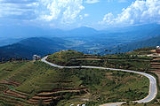
Agriculture in Nepal
Encyclopedia
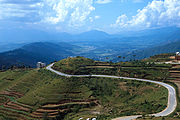
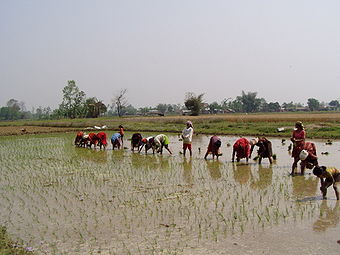
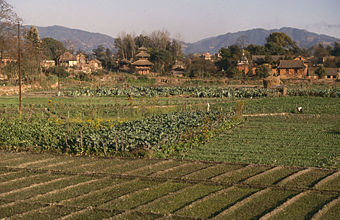
Nepal
Nepal , officially the Federal Democratic Republic of Nepal, is a landlocked sovereign state located in South Asia. It is located in the Himalayas and bordered to the north by the People's Republic of China, and to the south, east, and west by the Republic of India...
, the economy is dominated by agriculture. In the late 1980s, it was the livelihood for more than 90 percent of the population, although only approximately 20 percent of the total land area was cultivable, it accounted for, on average, about 60 percent of the GDP and approximately 75 percent of exports. Since the formulation of the Fifth Five-Year Plan (1975–80), agriculture has been the highest priority because economic growth was dependent on both increasing the productivity of existing crops and diversifying the agricultural base for use as industrial inputs.
According to the World Bank, agriculture is the main source of food, income, and employment for the majority.
In trying to increase agricultural production and diversify the agricultural base, the government focused on irrigation, the use of fertilizer
Fertilizer
Fertilizer is any organic or inorganic material of natural or synthetic origin that is added to a soil to supply one or more plant nutrients essential to the growth of plants. A recent assessment found that about 40 to 60% of crop yields are attributable to commercial fertilizer use...
s and insecticide
Insecticide
An insecticide is a pesticide used against insects. They include ovicides and larvicides used against the eggs and larvae of insects respectively. Insecticides are used in agriculture, medicine, industry and the household. The use of insecticides is believed to be one of the major factors behind...
s, the introduction of new implements and new seeds of high-yield varieties, and the provision of credit. The lack of distribution of these inputs, as well as problems in obtaining supplies, however, inhibited progress. Although land reclamation and settlement were occurring in the Tarai Region, environmental degradation and ecological imbalance resulting from deforestation also prevented progress.
Although new agricultural technologies helped increase food production, there still was room for further growth. Past experience indicated bottlenecks, however, in using modern technology to achieve a healthy growth. The conflicting goals of producing cash crops both for food and for industrial inputs also were problematic.
The production of crops fluctuated widely as a result of these factors as well as weather conditions. Although agricultural production grew at an average annual rate of 2.4 percent from 1974 to 1989, it did not keep pace with population growth, which increased at an average annual rate of 2.6 percent over the same period. Further, the annual average growth rate of food grain production was only 1.2 percent during the same period.
There were some successes. Fertile lands in the Tarai Region and hardworking peasants in the Hill Region provided greater supplies of food staples (mostly rice and corn), increasing the daily caloric intake of the population locally to over 2,000 calories per capita in 1988 from about 1,900 per capita in 1965. Moreover, areas with access to irrigation facilities increased from approximately 6,200 hectares in 1956 to nearly 583,000 hectares by 1990.
Crops
RiceRice
Rice is the seed of the monocot plants Oryza sativa or Oryza glaberrima . As a cereal grain, it is the most important staple food for a large part of the world's human population, especially in East Asia, Southeast Asia, South Asia, the Middle East, and the West Indies...
is the most important cereal crop. In 1966 total rice production amounted to a little more than 1 million tons; by 1989 more than 3 million tons were produced. Fluctuation in rice production was very common because of changes in rainfall; overall, however, rice production had increased following the introduction of new cultivation techniques as well as increases in cultivated land. By 1988 approximately 3.9 million hectares of land were under paddy cultivation. Many people in Nepal devote their lives to cultivating rice to survive. In 1966 approximately 500,000 tons of corn, the second major food crop, were produced. By 1989 corn
Maize
Maize known in many English-speaking countries as corn or mielie/mealie, is a grain domesticated by indigenous peoples in Mesoamerica in prehistoric times. The leafy stalk produces ears which contain seeds called kernels. Though technically a grain, maize kernels are used in cooking as a vegetable...
production had increased to over 1 million tons.
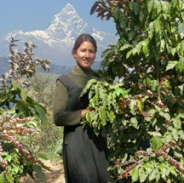
Wheat
Wheat is a cereal grain, originally from the Levant region of the Near East, but now cultivated worldwide. In 2007 world production of wheat was 607 million tons, making it the third most-produced cereal after maize and rice...
, millet
Millet
The millets are a group of small-seeded species of cereal crops or grains, widely grown around the world for food and fodder. They do not form a taxonomic group, but rather a functional or agronomic one. Their essential similarities are that they are small-seeded grasses grown in difficult...
, barley
Barley
Barley is a major cereal grain, a member of the grass family. It serves as a major animal fodder, as a base malt for beer and certain distilled beverages, and as a component of various health foods...
, and coffee
Coffee
Coffee is a brewed beverage with a dark,init brooo acidic flavor prepared from the roasted seeds of the coffee plant, colloquially called coffee beans. The beans are found in coffee cherries, which grow on trees cultivated in over 70 countries, primarily in equatorial Latin America, Southeast Asia,...
, but their contribution to the agricultural sector was small. Increased production of cash crops, used as input to new industries, dominated in the early 1970s. Sugarcane
Sugarcane
Sugarcane refers to any of six to 37 species of tall perennial grasses of the genus Saccharum . Native to the warm temperate to tropical regions of South Asia, they have stout, jointed, fibrous stalks that are rich in sugar, and measure two to six metres tall...
and tobacco
Tobacco
Tobacco is an agricultural product processed from the leaves of plants in the genus Nicotiana. It can be consumed, used as a pesticide and, in the form of nicotine tartrate, used in some medicines...
also showed considerable increases in production from the 1970s to the l980s. Potatoes and oilseed production had shown moderate growth since 1980. Medicinal herbs were grown in the north on the slopes of the Himalayas
Himalayas
The Himalaya Range or Himalaya Mountains Sanskrit: Devanagari: हिमालय, literally "abode of snow"), usually called the Himalayas or Himalaya for short, is a mountain range in Asia, separating the Indian subcontinent from the Tibetan Plateau...
, but increases in production were limited by continued environmental degradation. According to government statistics, production of milk
Milk
Milk is a white liquid produced by the mammary glands of mammals. It is the primary source of nutrition for young mammals before they are able to digest other types of food. Early-lactation milk contains colostrum, which carries the mother's antibodies to the baby and can reduce the risk of many...
, meat, and fruit had improved but as of the late 1980s still had not reached a point where nutritionally balanced food was available to most people. Additionally, the increases in meat and milk production had not met the desired level of output as of 1989.
Nepal has more than 50% of people engaged in agricuture.
Food grains contributed 76 percent of total crop production in 1988-89. In 1989-90 despite poor weather conditions and a lack of agricultural inputs, particularly fertilizer, there was a production increase of 5 percent. In fact, severe weather fluctuations often affected production levels. Some of the gains in production through the 1980s were due to increased productivity of the work force (about 7 percent over fifteen years); other gains were due to increased land use and favorable weather conditions.
According to Statistical Information on Nepalese Agriculture (2008/2009) only 65.6% of peolple depends on agriculture and 21% of land is cultivated where as 6.99% of land is uncultivated.

